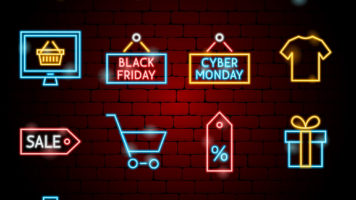Black Friday Countdown
At this writing, there are — shockingly — only 46 days left until Black Friday. We mean the real and official Black Friday, on the day after Thanksgiving. Not the fake “Black Fridays” we see more and more frequently year-round to invoke yet another retail sales promotion.
This real Black Friday is serious stuff: official gateway to retail’s Holiday Peak, which accounts for a major share of annual retail sales and profits. The typical retail Black Friday event usually begins in the several days leading up to Black Friday itself, and extends through the Thanksgiving weekend to Cyber Monday, which in turn has now become a “Cyber Week” event. So . . . it’s time for a few reminders about managing email for this hugely important event and the subsequent period.
There is, unsurprisingly, one word that unifies our entire message on Holiday email: AMAZON. Here’s why:
- Their enormous email audience strongly overlaps almost everyone’s else’s. If you’re a commercial e-mailer in the B2C space, there’s a better than 50% chance that your email audience is also getting email from Amazon. This means that Amazon is not only competing with you on product; but also for attention in your customer’s inboxes.
- They maintain a huge email activity footprint. Not counting transactional email, they deploy many more email campaigns than even their largest retail competitors (e.g., Walmart).
- They start their Black Friday related mailings lots earlier than others do. We typically see Amazon’s Black Friday/Cyber Monday or other Holiday-themed emails first deploying up to thirty days in advance of Black Friday. Similar email from other retail brands usually kicks-off with about half the lead time Amazon creates.
- They’re highly sophisticated, disciplined, targeted email marketers. Their marketing messages are curated and deployed based on customer purchase/browse behavior and other factors describing each customer’s location and status. Their targeting percentages (audience depth of file for each marketing campaign) are consistently the lowest (i.e., most targeting) we see anywhere in major retail.
- They reflect this precision in their subject line wording. Subject line keywords most frequently reflect very specific specific merchandise category focus, in addition to any price-promotion also being featured.
- They’re mobile-optimized. The percentage of their email that’s we see as “mobile-ready” is usually twice is high as we see of other brands in the retail sector.
- And the results? The overall intelligence of Amazon’s approach is reflected in Amazon’s having among the best inbox performance In retail — consistently in the 95-97% range, and average read rates that are usually at least 2-3 percentage points better than those of their largest retail competitors, and the percentage of their email subscribers with recent activity is also considerably higher. These are not trivial differences, considering the volumes involved.
Key Takeaways
- Time is of the essence. Try not to allow Amazon the two-week timing advantage they’ve customarily taken.
- Focus on deliverability. Getting to your customer’s inbox is more critical for retailers at Holiday than at any other time, and tougher this year than ever, given intensified ISP filtering based on recent email engagement. This means having the best possible acquisition and opt-in practices, solid list maintenance and hygiene, intelligent audience and program optimization practices, and not mailing into audiences that haven’t engaged with your email in the past 90-120 days. Which takes us to the next point, and the point after that.
- Relevance rules. Target emails to those audiences most likely to respond, based on everything you know about your customers. Reflect that relevance in subject line personalization keyed to location and featured merchandise or service categories.
- Get right with mobile. With mobile opens now well past 70% of retail email, it’s more critical than ever that your email and websites are mobile-optimized. We still see a surprising percentage of emails that are not.







